just because you measure 12V there doesn't ncessarily mean it can supply any current at that voltage... Feel free to try it, but it might either not work (can't supply the current) or blow something up...
Is there such a thing as a Low voltage or POE powered IR Illuminator?
- Thread starter nbstl68
- Start date
-
- Tags
- 940nm ir illuminator poe
You are using an out of date browser. It may not display this or other websites correctly.
You should upgrade or use an alternative browser.
You should upgrade or use an alternative browser.

17.14US $ 7% OFF|Smar H.264 Bullet Ip Camera 720p 960p 1080p Security Camera Outdoor/indoor 24 Hours Video Surveillance Onvif Poe 48v Optional - Ip Camera - AliExpress
Smarter Shopping, Better Living! Aliexpress.com
These are the cameras I've been using, the 720p 48v one, covers about as much area in IR light as the 150w security light I used to have to use with my PTZ cameras. The ad says these are 720p but they are more like VGA and the software triggered Malwarebytes several times so don't even try to use them as cameras. Just leave them on the default IP and the day/night relay for the IR lights just works out of the box.
tigerwillow1
Known around here
Dahua camera mod to power external IR lightI'm re-considering my idea of using the 12 V input connector on a camera as a 12 V output. Has anyone tried this?
I've modified several different Dahua model cameras to power an external IR illuminator. At least a few of the POE supply components are the same in every one I've looked at. The first component connected to the 12 volt power input is a diode to prevent 12 volt power from going out of the camera. All it takes to supply the connector with 12 volts from the camera is to bridge this diode. Every time I do this I first warn my wife that I might be destroying a perfectly good camera. Here's a picture of the mod for an IPC-T5442T-ZE:

TheWaterbug
Known around here
Dahua camera mod to power external IR light
I've modified several different Dahua model cameras to power an external IR illuminator. At least a few of the POE supply components are the same in every one I've looked at. The first component connected to the 12 volt power input is a diode to prevent 12 volt power from going out of the camera. All it takes to supply the connector with 12 volts from the camera is to bridge this diode. Every time I do this I first warn my wife that I might be destroying a perfectly good camera. Here's a picture of the mod for an IPC-T5442T-ZE:
View attachment 82109
Ah, perfect! That's exactly what I was looking for. I dissembled an old Reolink RLC-410S:
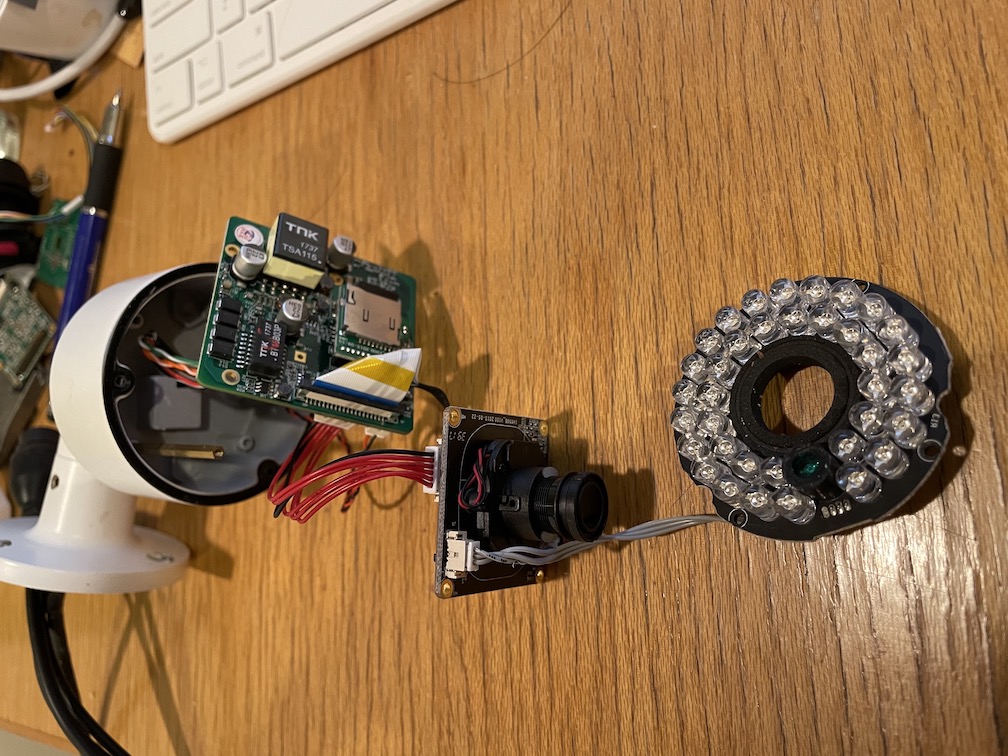
Here's the back side, where the main cable comes in (left side of the photo):
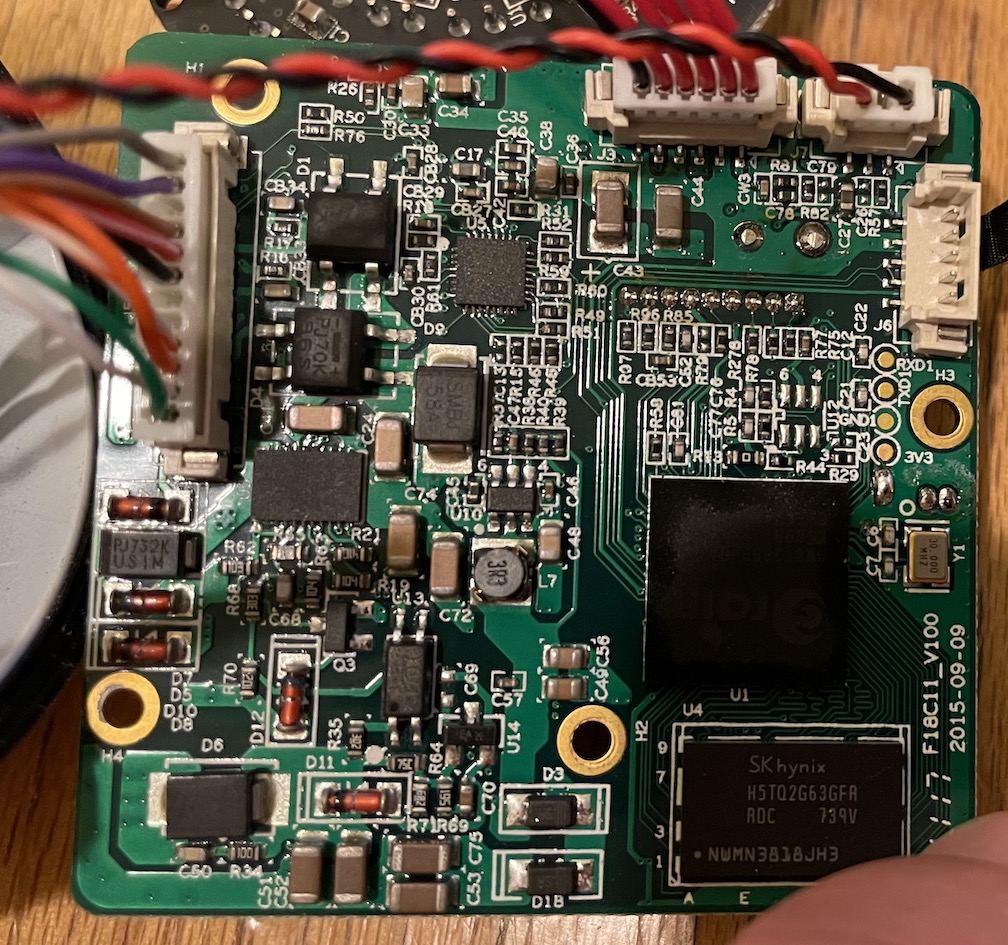
And here's the front side (e.g. the side that faces the front of the camera). The main cable comes on the left side of the photo, just behind those 4 identical black rectangular components:
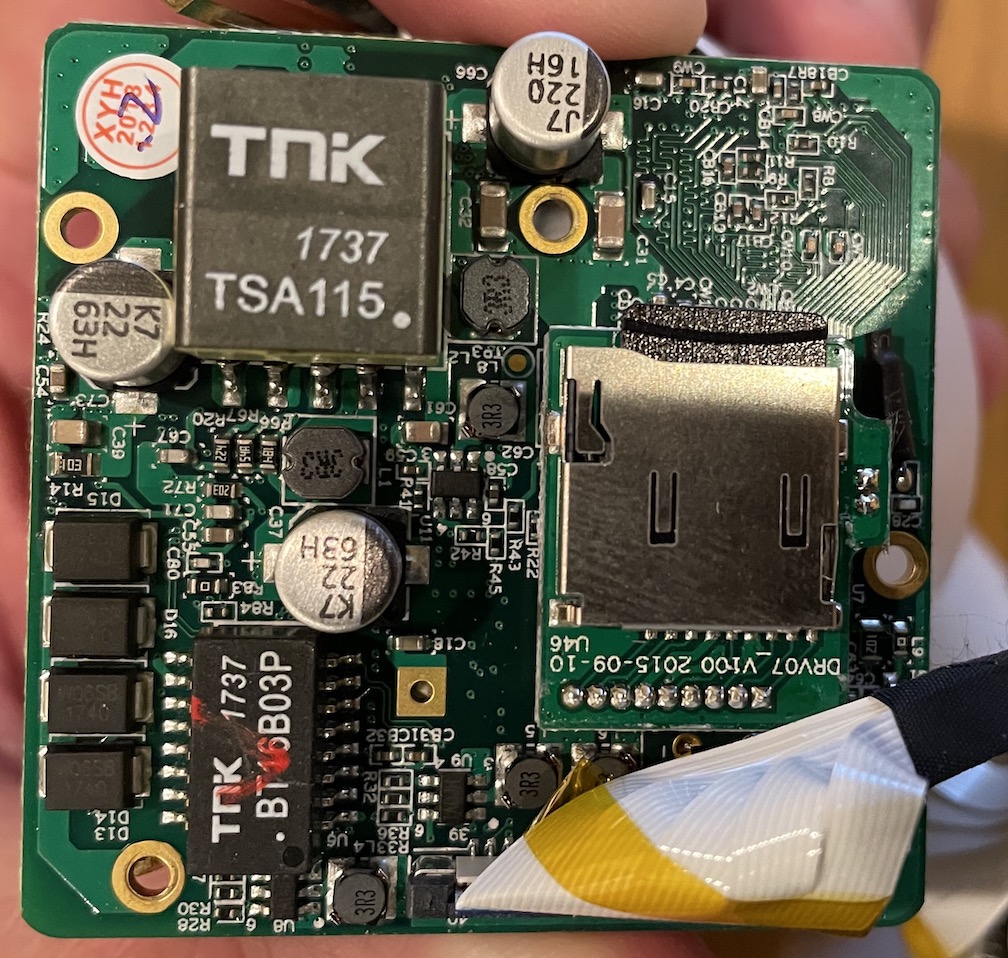
Does anything there look like a promising diode to bypass?
I suppose if I measure with an ohmmeter from the center pin of the external 12 V connector, I'm looking for a point on the board with the lowest resistance, right?
tigerwillow1
Known around here
The dahua cameras have another hint I don't see here, a "+" screened on the circuit board next to the diode that needs to be bridged. Assuming there really is a backfeed protection diode in the 12 volt input line, I'd vote to check them in this order:
D5
D6, D9
D3, D1B
D13, D14, D15, D16
The TSA115 component I believe is the transformer used in the POE circuit.
You want to check for a direct connection from the center pin of the 12 volt input to one of the diodes. Shouldn't be more than a couple tenths of an ohm. I would first identify which wire in the 12 position connector from the network and power connectors goes with the power connector center pin, then take the resistance measurements between the 12-position connector and diode. Sorry if I sound like a broken record, don't do it if you're not willing to risk bricking the camera.
D5
D6, D9
D3, D1B
D13, D14, D15, D16
The TSA115 component I believe is the transformer used in the POE circuit.
You want to check for a direct connection from the center pin of the 12 volt input to one of the diodes. Shouldn't be more than a couple tenths of an ohm. I would first identify which wire in the 12 position connector from the network and power connectors goes with the power connector center pin, then take the resistance measurements between the 12-position connector and diode. Sorry if I sound like a broken record, don't do it if you're not willing to risk bricking the camera.
TheWaterbug
Known around here
^^ Thanks for the tips!
Acknowledged! This is a camera that I decommissioned because it's Flash-only in a browser, and can't be updated, and had RTSP problems in dark regardless, and was spontaneously rebooting itself several times/day anyway, so it's no great loss if I fry it.
Sorry if I sound like a broken record, don't do it if you're not willing to risk bricking the camera.
Acknowledged! This is a camera that I decommissioned because it's Flash-only in a browser, and can't be updated, and had RTSP problems in dark regardless, and was spontaneously rebooting itself several times/day anyway, so it's no great loss if I fry it.
TheWaterbug
Known around here
I actually gave up on the old Reolink camera because I thought, even if I do bypass that diode, I'm still not going to use that camera.
So I bought myself another IP5M-B1186EW-28MM. Before surgery I measured about 1.2 V at the center pin of the 12 V "input" connector.
As it turns out, every diode on the board has a "+" screened on the circuit board next to it!
But I did use this method to find the most likely diode, right next to the input cable. Unfortunately it's hiding under the lens/filter assembly, so I had to remove that first. I'm a terrible solderer, and even terrible-er with my 50-yr-old eyes, but I got 'er done:
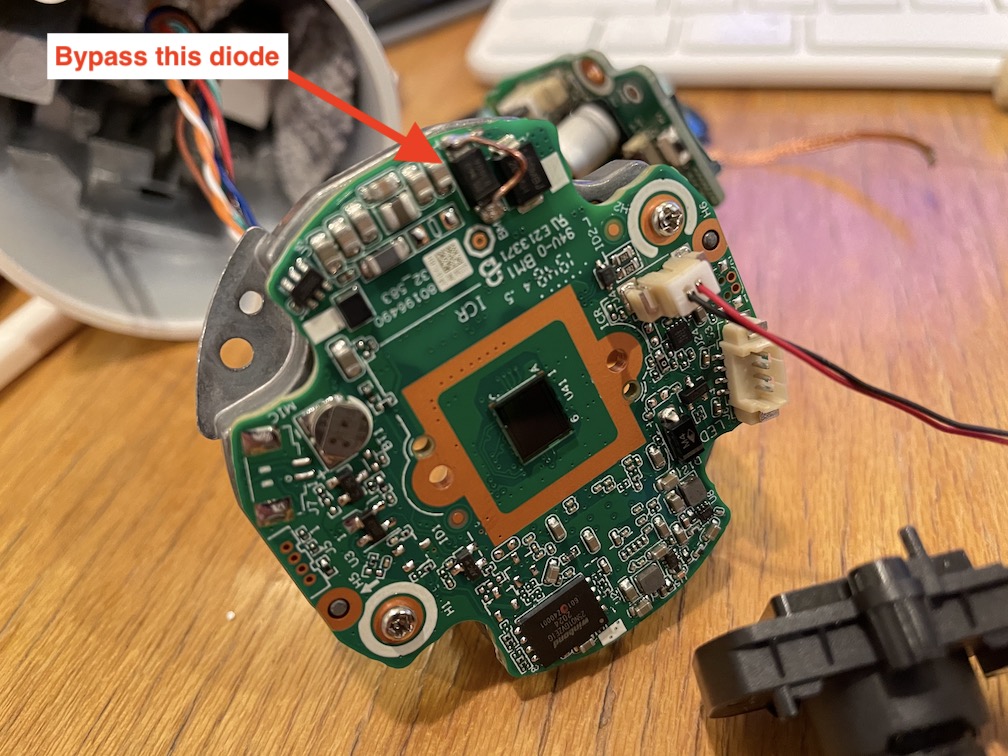
The camera still works , and now I measure 12 V at the center pin of the 12 V "input" connector. I'll hook it all up to the IR illuminator and POE switch in the next few days.
, and now I measure 12 V at the center pin of the 12 V "input" connector. I'll hook it all up to the IR illuminator and POE switch in the next few days.
So I bought myself another IP5M-B1186EW-28MM. Before surgery I measured about 1.2 V at the center pin of the 12 V "input" connector.
The dahua cameras have another hint I don't see here, a "+" screened on the circuit board next to the diode that needs to be bridged.
As it turns out, every diode on the board has a "+" screened on the circuit board next to it!

You want to check for a direct connection from the center pin of the 12 volt input to one of the diodes.
But I did use this method to find the most likely diode, right next to the input cable. Unfortunately it's hiding under the lens/filter assembly, so I had to remove that first. I'm a terrible solderer, and even terrible-er with my 50-yr-old eyes, but I got 'er done:

The camera still works
TheWaterbug
Known around here
It works! I plugged the external illuminator into the camera's 12 V "input" port with the two male ends of the 2.1 mm splitter cable, plugged in the POE cable, and voila!
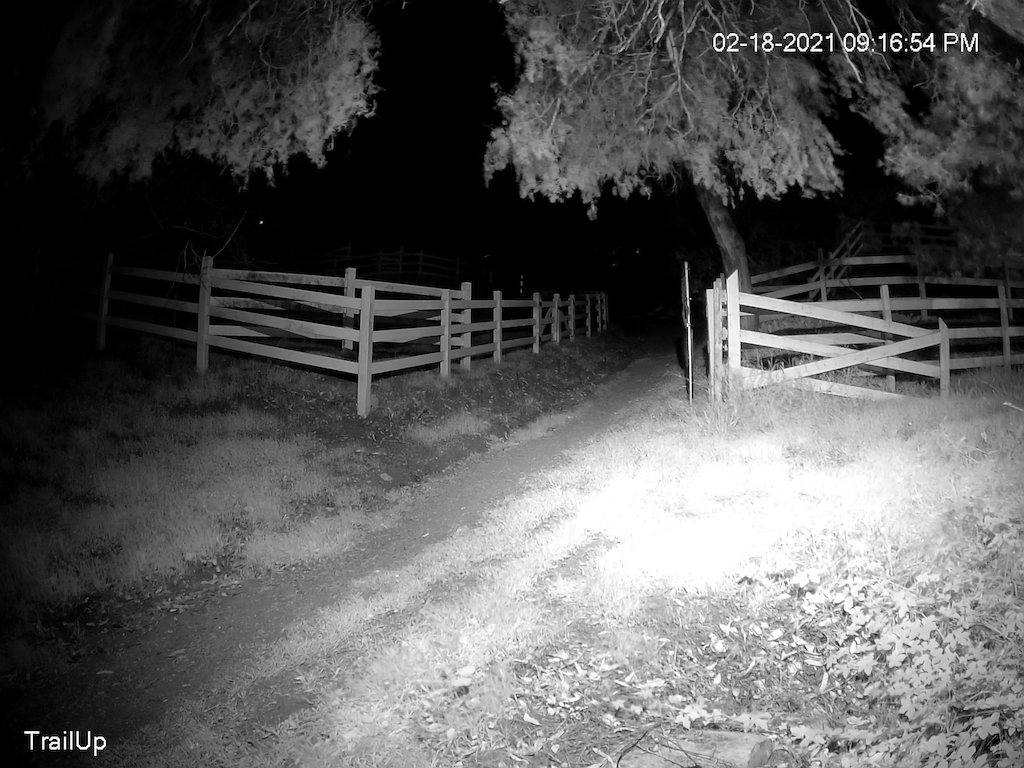
That illuminator isn't quite as wide angle as I'd hoped, and there's that giant bright spot in the middle. But if there are no spiders, then I'll be a happy man.
I'm thinking of buying another illuminator and doing the same on the downhill side. Anyone have a recommendation for a better illuminator than the one I've got now, for not too much money?

That illuminator isn't quite as wide angle as I'd hoped, and there's that giant bright spot in the middle. But if there are no spiders, then I'll be a happy man.
I'm thinking of buying another illuminator and doing the same on the downhill side. Anyone have a recommendation for a better illuminator than the one I've got now, for not too much money?
TheWaterbug
Known around here
Ah, and I forgot to mention a caution--when you remove and then remount the lens assembly to get to the 12 V diode, you will likely mess up the focus. I reassembled and mounted the camera without checking, and then had to unmount it, disassemble it, refocus it, reassemble it, and remount it. Wasted nearly an hour vs. checking the focus immediately upon remounting the lens assembly.
tigerwillow1
Known around here
4 watt IR illuminator comparison
Also look at the 2-year update a few posts down. For the 4-watters, the IR-40 and AI4 are the only two that are worth using IMO. From the picture above it looks like your FOV is fairly narrow so maybe a single illuminator will do. I get the best coverage using two of them with the hotspots distributed, but my cameras won't drive two 4-watters. I use a POE splitter when powering two illuminators. There are male-male power adapters available if you want to reduce the wire mess from the spitter cable. In a few cases I point the illuminator a bit upward so it doesn't light up the ground so much. The camera compensates for this and makes everything else darker.
Also look at the 2-year update a few posts down. For the 4-watters, the IR-40 and AI4 are the only two that are worth using IMO. From the picture above it looks like your FOV is fairly narrow so maybe a single illuminator will do. I get the best coverage using two of them with the hotspots distributed, but my cameras won't drive two 4-watters. I use a POE splitter when powering two illuminators. There are male-male power adapters available if you want to reduce the wire mess from the spitter cable. In a few cases I point the illuminator a bit upward so it doesn't light up the ground so much. The camera compensates for this and makes everything else darker.
TheWaterbug
Known around here
For the 4-watters, the IR-40 and AI4 are the only two that are worth using IMO. From the picture above it looks like your FOV is fairly narrow so maybe a single illuminator will do. I get the best coverage using two of them with the hotspots distributed, but my cameras won't drive two 4-watters. I use a POE splitter when powering two illuminators. There are male-male power adapters available if you want to reduce the wire mess from the spitter cable. In a few cases I point the illuminator a bit upward so it doesn't light up the ground so much. The camera compensates for this and makes everything else darker.
Thanks! I ordered a pair of the IR-40 units and some male/male adapter cables. The illuminators won't arrive from China for another week or two.
I'll try angling my existing illuminator upward a tad, but I might leave it where it is, too. Sometimes the coyote is very near the camera, and I want to be sure he's well lit-up. I've been saying "he" for the last few months without actually knowing, but now we know



TheWaterbug
Known around here
I saw that you applied this mod to a turret/eyeball camera as well. Anything different when working on this form factor? After buying four of the Amcrest IP5M-B1186EW-28MM units I suddenly realized that none of them has audio


 . And I can't return them because they've all been surgically altered for focus or for power.
. And I can't return them because they've all been surgically altered for focus or for power.I'm thinking about replacing at least one of them with what appears to be the equivalent eyeball, the IP5M-T1179EW-28MM, which has all the same specs, plus audio, for $8 less

But I need to bypass the 12 V power diode on that one, too, if I'm going to use it as a replacement.
tigerwillow1
Known around here
Component-wise I've found no difference between turret vs. bullet. Each model has been different physically and in general working with the varifocals is more complex. I've bought the IR-40s from the cmvision web site or their ebay store and they've shipped from the USA, Houston I think. Browsing their web site today reminds me that my recommendation is for only this one model. I had tried cmvision's IR3 and IR4, and neither one lasted more than a couple of months.I saw that you applied this mod to a turret/eyeball camera as well. Anything different when working on this form factor?
TheWaterbug
Known around here
They arrived yesterday, 4 days after order placement. I connected one last night, but didn't mount it high up, and I caught my first coyote on this "downhill" camera. Seems to work fine with my diode-bypassed camera, and the mounting is both simpler and more flexible than that of my clunky 6W illuminator, because it allows for 2 axes of rotation.Thanks! I ordered a pair of the IR-40 units and some male/male adapter cables. The illuminators won't arrive from China for another week or two.
I'll try angling my existing illuminator upward a tad, but I might leave it where it is, too. Sometimes the coyote is very near the camera, and I want to be sure he's well lit-up. I've been saying "he" for the last few months without actually knowing, but now we know


tigerwillow1
Known around here
I have one of that same "clunky" Univivi illuminator and it has turned out to also be a good one. I use a splitter to power it.
TheWaterbug
Known around here
Amazon had these in stock, so I ordered yesterday and got it today! Disassembly on these is actually easier than on the bullet, because there are fewer pieces. Which probably explains the $8 price difference.I'm thinking about replacing at least one of them with what appears to be the equivalent eyeball, the IP5M-T1179EW-28MM, which has all the same specs, plus audio, for $8 less
But I need to bypass the 12 V power diode on that one, too, if I'm going to use it as a replacement.
The camera board looks like it's the exact same PCB as in the bullet, so I bypassed the same diode, and I have 12 V out for my IR-40 illuminator.
edit: Hmm. Maybe I should take both the eyeball and turret apart simultaneously and see where the microphone is(n't). I have 3 other decommissioned cameras right now; I wonder if it would be possible to connect a mic to the camera board on the bullet and enable it somehow.
TheWaterbug
Known around here
I still haven't fixed the mounting on the illuminators, but at least I now finally have 2 cameras with reliable in-camera motion trigger, which allows stuff like this (watch at least 50 seconds in, when the 2nd camera turns on):
